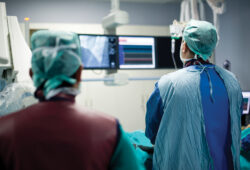Sepsis is the body’s overwhelming and life-threatening response to infection and can lead to tissue damage, organ failure and death. It kills some 258,000 Americans each year, according to the Sepsis Alliance.
Sepsis symptoms can include fever, hypothermia, edema, confusion, coma, low blood oxygen levels, rapid heart and respiratory rate, and organ failure.
Forty percent of patients who develop severe sepsis die, and up to half of those who survive suffer from post-sepsis syndrome with symptoms that include extreme fatigue, insomnia, nightmares, panic attacks, muscle and joint pain, and decreased cognitive functions.
There is no cure for sepsis, so early detection is the best way to ensure survival, according to the Sepsis Alliance.
“Sepsis strains all organ functions, so it is important to monitor fluid intake to prevent overloading the heart and kidneys. One of the standard treatments for patients battling sepsis is to administer intravenous fluids, although only half of all sepsis patients respond to fluid therapy.”
— Angie Mitchell, RN
Changes in cardiac functions can signal the onset of sepsis, and also help guide clinicians in combating the condition. In the past, physicians used central line catheters to monitor hemodynamics, such as stroke volume, but that procedure carries its own risk of infection and other complications, explains Angie Mitchell, RN, former director of Nursing Services for HealthTrust’s Clinical Operations team.
As a result, central line use is being discouraged except in certain specific situations. Clinicians instead are turning to non-invasive means to monitor stroke volume and other values that change with infection. HealthTrust has contracts with suppliers that offer different non-invasive approaches.
Cheetah Medical’s NICOM and Starling SV Monitor systems employ a technology called Bioreactance that uses four disposable sensors—two above the heart and two below—that continuously measure the time delay between a small electrical current applied to the thorax and a small voltage on the thorax. The delay is proportional to the flow of blood from the heart, which Cheetah says provides a high degree of accuracy in measuring cardiac hemodynamics.
Cheetah’s systems differ from other devices because they measure dynamic parameters, including stroke volume, directly at the source—the beating heart, says Daniel Draper, Cheetah Medicals’ strategic marketing manager. “By providing a measure of the volume of blood leaving the heart, Cheetah monitors are unaffected by the limitations of pressure measurements, including CVP [central venous pressure] and pulse pressure.”
The Cheetah NICOM system is easy and quick to use and has become “a key component in managing our severe sepsis and septic shock patients while improving their mortality,” says Carol Golas, ICU RN, the sepsis coordinator at the Medical Center of Aurora, Colorado.
Edwards Lifesciences’ ClearSight system uses a small inflatable finger cuff to measure blood pressure, cardiac output, stroke volume and stroke volume variation, says Tim Patz, Edwards’ senior director, U.S. Critical Care Marketing.
A single cuff can be used for up to eight hours before the system alerts the user to switch fingers. Or clinicians may use two cuffs for continuous monitoring for up to 72 hours.
Identifying cardiac dysfunction may be particularly valuable in patients with sepsis and septic shock, as it serves as a major predictor of hospital mortality, Patz says.
To identify septic patients in the emergency room and hospital floors, clinicians look for two key signs: systemic immune response syndrome and organ dysfunction.
“Recently, two HealthTrust hospitals used the ClearSight system to manage patients meeting these criteria,” Patz says. “Clinicians used the hemodynamic parameters provided by the system to help guide fluid therapy; specifically, using the dynamic measurement of stroke volume to assess if patients were responsive following a fluid bolus or a passive leg raise maneuver.
“A large body of evidence demonstrates that hemodynamic optimization through perioperative goal-directed therapy has been shown to reduce post-surgical complications and length of stay,” he continues.
Sepsis strains all organ functions, so it is important to monitor fluid intake to prevent overloading the heart and kidneys, Mitchell says. One of the standard treatments for patients battling sepsis is to administer intravenous fluids, although only half of all sepsis patients respond to fluid therapy. Without a way to measure hemodynamics, she says, it can be difficult to determine how a patient is handling fluids until problems such as edema, kidney failure or drastic blood pressure changes arise.
Both the Cheetah and the Edwards systems provide fluid management guidance for treating patients with sepsis or septic shock, and in other situations where fluid balance is critical.
Mitchell notes hospitals are not reimbursed for using these technologies. Each system requires a capital equipment purchase of more than $10,000, not including the disposable finger probe or electrodes.
“However, hospitals will realize a return on that upfront investment when using technology that helps prevent complications and facilitates a shortened hospital stay,” Mitchell says.
Share Email





